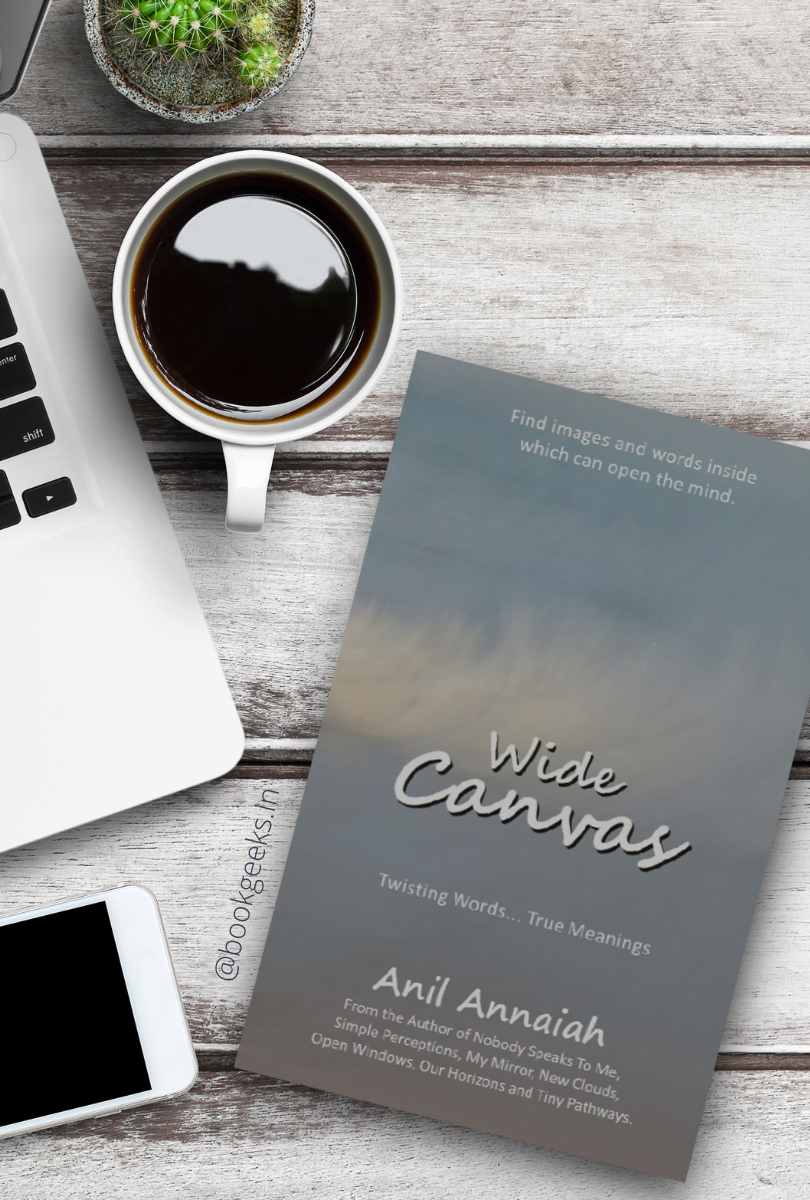PLOT: 3.5/5 CHARACTERS: 3.5/5 WRITING STYLE: 3.5/5 CLIMAX: 3.5/5 ENTERTAINMENT QUOTIENT: 3.5/5
Like the famous adage goes which states that simplicity is the ultimate sophistication, Wide Canvas by Anil Annaiah embodies exactly that. Simple, sophisticated, and evocative, this book is the seventh in a series after books by Annaiah like “Simple Perceptions”, “My Mirror”, “New Clouds”, “Open Windows”, “Our Horizons” and “Tiny Pathways.”
Wide Canvas resonates with the thoughts and ideas of the author who uses the pages of the book to chalk down thoughts that will act as seeds of ideas that find germination in the minds of readers.
This sort of creates a relation between the author and the reader wherein the author entrusts the reader with his thoughts which are the impressions of external stimuli which have hit his mind with electrifying thoughts that he brings out through expressing himself.
This ties the author and the reader in a bond, one that is marked by an exchange of ideas, and an openness to change by allowing new views to flower, and a freshness that is channelized in two different ways, namely the written word and the visual representation.
The visual input in his book adds to the imagination of the reader who can find multi-directional and multi-dimensional interpretations of the words written in it.
In this sense, the book is one of the many canvases that Annaiah uses to assemble his thoughts and to give power to his capacity to think. The words in this book are like anecdotes, analogies, or can be even considered as a collection of quotations which are the words of the author.
These two-liners or simple adage-like sentences are full of vigour. They resonate a charm that is enticing and lays bare the notion that such thoughts come from a mind that thinks in a systematic and sound manner.
There is no haphazard aspect to these thoughts. They are in line with the core theme of the book which is all about engaging the reader in universal truths to garner a love for the world around him and those that live in the lap of that world, mostly the natural habitat.
At the end of the day, life has its fair share of ups and downs and this struggle of life is one of the key themes of this book. Annaiah is headstrong in narrating the need to master the mind game when life throws hurdles at man.
In mastering the mind, there is a keen understanding of the ability to feel empowered and the need to empower those around. In every situation and case in point, Annaiah is of the view that words serve to make or break individuals.
Hence, he is of the firm opinion that one must speak good words to oneself and to those around because words once spoken lead to a chain of thoughts in the mind that will decide whether these words will help in allowing the individual to combat the challenges in life or not.
The question then arises: What kind of good words need to be reiterated to the self? The view of the author is that mere words of positivity, encouragement, and diligence will not suffice. It must also be followed with proper and prompt action.
So, the appropriateness of the words matters as the author notes that life is full of inconsistencies. The only way to feel complete without feeling overloaded is to accept them and hold on to them.
The reader will find in this book several key takeaways such as the importance of striking a balance in life between positive and negative thoughts, and the need to create a better understanding of the situations in life by addressing them with the appropriate terms.
This should be accompanied by acknowledging the need to reassess oneself at all times to ensure the proper creation of a mechanism of combat.
This is all to be done with a sense of remedial measure, kind of like the role that a first aid kit plays. It does not heal immediately but at least it tackles the situation at hand in a swift and proper manner.
There are no specific characters in this book on whom the sayings are based. There is a sense of universality in the sayings that makes it applicable to all with a consideration that every individual is the main character in their story and that every story is equally important and worth being told or heard.
Hence, the reader becomes the chief character in this text and the reader is expected to devour this book by taking his or her own time. The book can be read in any order with no specific chronology that needs to be followed.
The easygoing, conversational, honest narrative voice creates a writing style that is clear, concise, and creatively engaging for the reader. The sayings are uniquely presented as a photograph follows each saying which makes the book colourful and thought-provoking at the same time.
On the whole, Wide Canvas is a short book but a deep read and a rather thoughtful endeavour on the author’s part. Currently, this book is a rage on Amazon India and has ranked #9 in Photography books making it a best seller.
Can’t wait to read it? Buy your copy of Wide Canvas right away!
